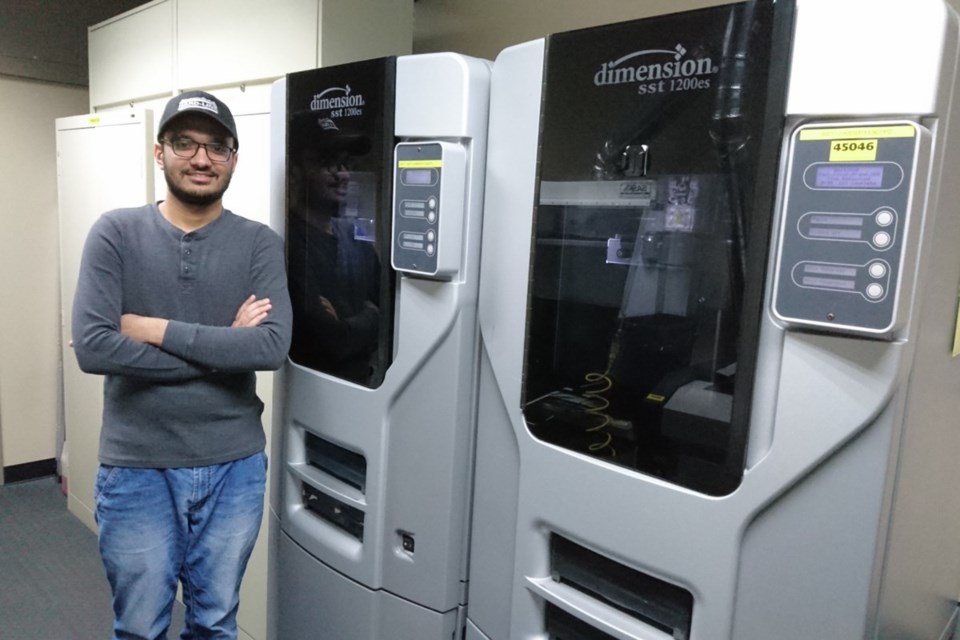A Sudbury-wide initiative to 3D-print components of personal protective equipment (PPE) for the local hospital all comes down to relationships.
That’s how Gisele Roberts views a recent project that’s mobilizing 11 partners to print out face shield headbands for health-care workers on the front lines of the COVID-19 pandemic at Health Sciences North.
Roberts, who’s leading the venture, said everyone who’s been approached has jumped on board to do their part.
"That’s what's so great about this initiative is that everybody is so keen to help out and do something,” said Roberts, the manager of innovation and commercialization at Laurentian University.
Partners include educational institutions, such as Laurentian, Collège Boréal, Cambrian College, and the Northern Ontario School of Medicine, as well as Lively District Secondary School and Lo-Ellen Park Secondary School.
Science institutions like SNOLAB and Science North are involved, as are industry partners Ionic Mechatronics, SHYFTInc and Hard-Line.
In March, well-intentioned contacts had been forwarding Roberts news stories about companies like Waterloo’s InkSmith, which retooled its production line to produce face shields to protect health-care workers on the front lines of the COVID-19 crisis.
It started Roberts thinking about what could be done at home to support local health-care efforts.
But before jumping in, Roberts wanted to find out what the hospital actually needed and would use.
Want to read more stories about business in the North? Subscribe to our newsletter.
So, she submitted an inquiry through the hospital’s PPE donation inquiry email address and waited.
In the meantime, she began taking stock of the equipment and machinery available at the university.
Just last year, for example, Laurentian received FedNor funding of $150,000 (announced in February) to purchase 3D printers, laser cutters, virtual and augmented reality equipment, and a digital media lab for its maker space in the Cliff Fielding Research, Innovation and Engineering Building.
“If it comes to the point where we could be asked to manufacture or create these items, what do we have at Laurentian?” Roberts thought.
“Then, after an exchange with (SNOLAB director) Nigel Smith, we decided to expand it beyond Laurentian to some of our partners in the community, so we could mobilize quickly if a request came through.”
At the SNOLAB, where researchers study neutrino and dark matter physics two kilometres underground at Vale’s Creighton nickel mine, Smith indicated that some of the staff members had 3D printers and would be open to printing components at home.
Ionic Mechatronics and Hard-Line, technology companies that serve the mining industry, offered up their 3D printers as well.
Through a work contact, Roberts learned that a teacher at Lively District Secondary School had a 3D printer, and he, too, was interested in helping out. And then he recruited a second high school to chip in.
Fairly quickly, Roberts had compiled a list of 11 partners – private industry, secondary and postsecondary institutions, and research institutes – that had signed up to contribute.
In conference with the Northern Ontario School of Medicine, the group decided on a plastic headband that attaches to a face shield, which can help stop the transmission of saliva or mucous droplets which could carry COVID-19.
Thanks to the Swedish company 3DVerkstan, an open-source file for the headband was easily accessible, and the printers got to work.
To date, the group has printed 750 of the headbands, which have now been delivered to Health Sciences North. Additional partners have come on board, she said.
For now, though, the project is on pause while the hospital evaluates its requirements.
But Roberts is encouraging the partners to source out other facilities in need, such as long-term care homes or hospitals in other communities.
Though other ideas have been circulating on how 3D printers can help out – parts for ventilators has been a common suggestion – Roberts said the group is holding off on launching any more production runs for now.
“My priority right now with this initiative is focusing on something that the hospital can use,” she said.
“Unless I get a request from the hospital about something specific, for now I'm just focusing on the face shields.”
But she’s been buoyed by the participation of local partners, who came together quickly, and didn’t hesitate when asked.
That, she said, is the power of personal relationships and a community call to action in the event of an emergency.
"I think there's an obligation, whether you're working for a post-secondary institution or you're a company in town,” Roberts said.
“We have access to smart people and we have access to resources, and in a pandemic like this, I think we all have an obligation to help out.”




